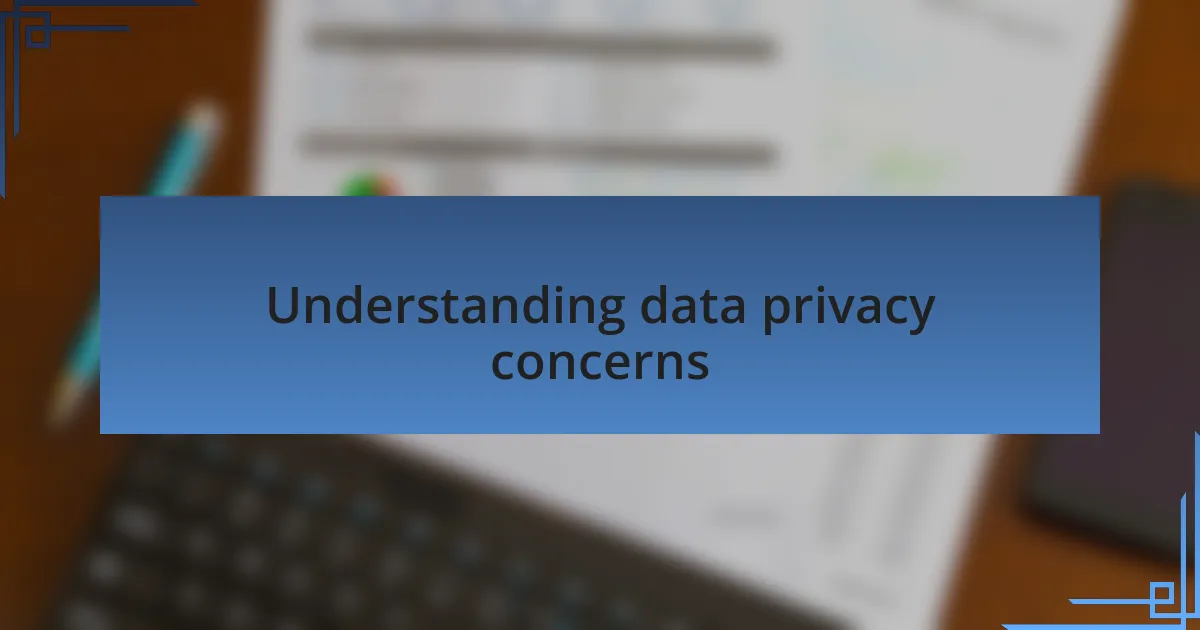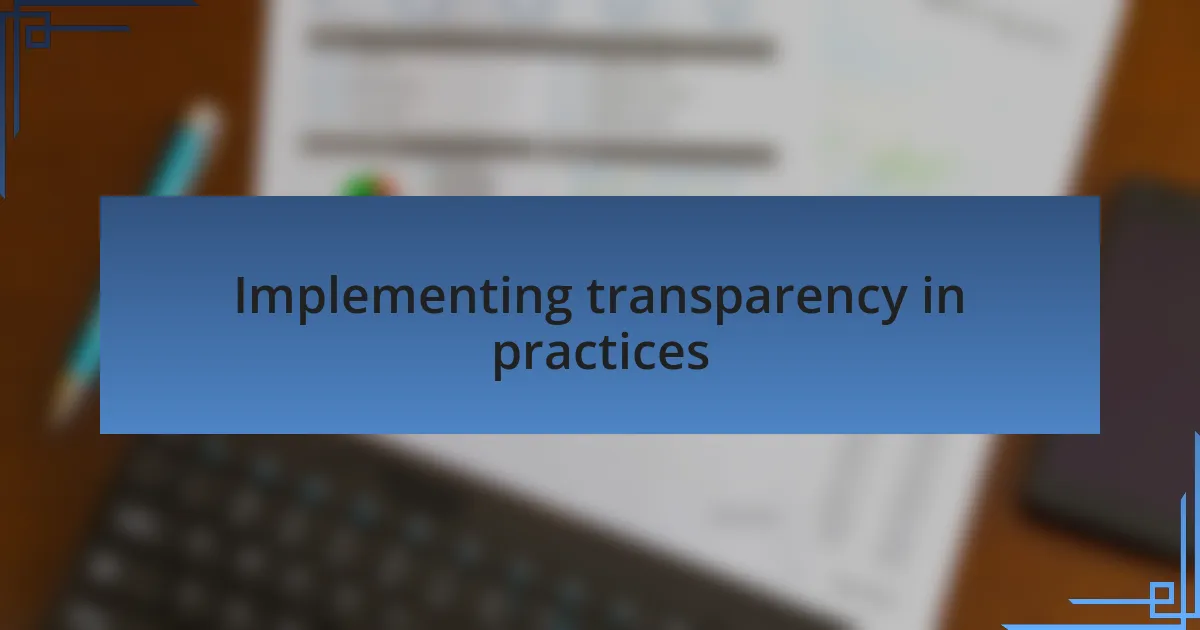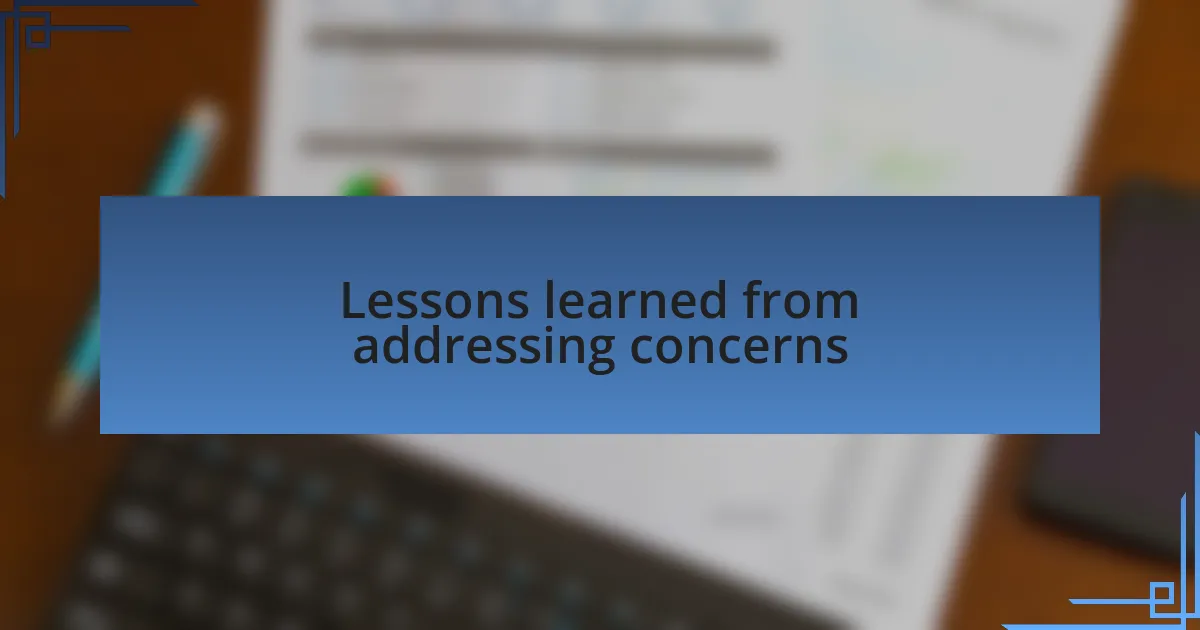Key takeaways:
- Data privacy concerns are prevalent, requiring marketers to balance data collection with user trust.
- Common regulations like GDPR and CCPA mandate explicit consent and transparency, enhancing consumer trust.
- Implementing strategies such as regular audits and employee training promotes a culture of accountability and responsibility in data handling.
- Open communication and transparency about data practices foster trust and empower clients to manage their own information.

Understanding data privacy concerns
Data privacy concerns are more than just buzzwords; they reflect a genuine fear shared by many individuals today. I remember a time when a friend of mine was hesitant to share her email address for a simple newsletter subscription, expressing anxiety that her personal information would be sold to third parties. This experience made me realize just how deeply rooted these concerns can be in our daily interactions online.
As digital marketers, we often walk a tightrope between gathering useful data and respecting user privacy. I’ve had countless discussions with clients who are eager to harness data for targeted marketing but are simultaneously wary of crossing ethical boundaries. It begs the question: how can we collect data responsibly without compromising trust?
In my journey, I’ve come to understand that transparency is key. I once worked with a startup that openly communicated how they used customer data, even going as far as explaining the measures they took to protect it. The response was overwhelmingly positive; customers felt valued and secure, demonstrating that addressing data privacy concerns head-on can turn hesitation into loyalty.

Common data privacy regulations
Common data privacy regulations encompass various frameworks aimed at protecting individuals’ personal information and ensuring responsible data handling. One of the most recognized regulations is the General Data Protection Regulation (GDPR), which came into effect in the European Union in 2018. It mandates that organizations obtain explicit consent before collecting personal data and enforce strict guidelines on how this data should be managed. I recall discussing GDPR with a colleague who was overwhelmed by its complexities, yet we agreed that its intent to protect individual rights was commendable.
Another notable regulation is the California Consumer Privacy Act (CCPA), which provides California residents with specific rights regarding their personal data. This act empowers consumers to know what data is being collected about them and gives them the ability to opt-out of data sales. I remember when a client in California expressed their concern about how this law could impact their marketing strategies. What we discovered was that embracing these regulations can actually enhance consumer trust.
There’s also the Health Insurance Portability and Accountability Act (HIPAA), which requires healthcare providers to protect patient information rigorously. As someone who once worked on a campaign for a healthcare startup, I saw firsthand how vital it was for compliance not just on paper, but in practice. They implemented privacy training for employees, and the effort genuinely showcased their commitment to patient confidentiality. Isn’t it fascinating how regulations can drive positive behavior in organizations while respecting individual rights?

Strategies for enhancing data privacy
One effective strategy I’ve found for enhancing data privacy is conducting regular privacy audits. These audits help identify potential vulnerabilities in data handling practices. I recall leading an audit for a client, and it was eye-opening to uncover how many outdated processes were still in place. This revelation not only improved their compliance but also fostered a culture of accountability among employees.
Another approach is to implement robust data encryption methods. When I worked on a project involving sensitive customer information, we prioritized encryption to mitigate risks associated with data breaches. The feeling of assurance that came from knowing we were taking proactive steps felt empowering. It made me realize that when you invest in encryption, you’re not just protecting data; you’re also safeguarding trust with your clients.
Training employees on data privacy is an often-overlooked strategy that yields substantial benefits. I once facilitated a workshop focused on privacy best practices, and I remember the enthusiasm that emerged among team members eager to learn. By equipping staff with knowledge, we not only reduced the likelihood of accidental data mishandling but also turned them into champions for data privacy in their daily work. Isn’t it remarkable how informed employees can become a company’s best line of defense?

Implementing transparency in practices
Implementing transparency in practices requires clear communication about how data is collected and used. In one project, I initiated a series of newsletters that outlined our data policies in straightforward language. The feedback from clients was overwhelmingly positive; they appreciated being kept in the loop and felt more secure knowing we were committed to transparency. It reinforced my belief that when clients understand the process, it not only builds trust but also strengthens the entire partnership.
Another important aspect of transparency involves providing clients easy access to their data. I once set up a client portal where users could review their data usage and request changes. Watching the relief on clients’ faces when they realized they had control over their information was rewarding. It prompted me to ask myself: how often do we truly give clients the power to manage their own data?
Additionally, I’ve found that hosting open forums can be incredibly beneficial in fostering transparency. During one of these sessions, clients voiced their concerns directly, which led to constructive dialogue about data practices. It felt invigorating to engage in honesty-first conversations; it reminded me that transparency isn’t just a policy—it’s a commitment to being accountable and approachable. How often do we create spaces for genuine discussions about sensitive topics like data privacy?

Personal experiences with data privacy
In my experience, navigating data privacy has often felt like walking a tightrope. I recall a time when a client expressed anxiety about how their information might be shared. Their vulnerability struck a chord with me, prompting a heartfelt conversation about the measures we had in place to safeguard their data. That moment taught me the importance of empathy in addressing privacy concerns, making it not just a technical challenge but a deeply human one.
Another instance that stands out occurred during a team meeting where we discussed data breaches affecting various industries. I shared a personal story about a breach I experienced, where my private information was leaked. The shock and frustration I felt were palpable, and it underscored for me that our clients have a genuine fear of vulnerability. How can we expect them to trust us if we don’t acknowledge their fears and work to alleviate them?
There was also a memorable workshop I held on data privacy—a space filled with curiosity and unease. One attendee bravely spoke up about their past experiences with mismanaged data, highlighting the emotional toll it had on them. That discussion became a catalyst for change in our agency’s approach. It made me realize that data privacy isn’t merely a checklist; it’s an ongoing conversation, one that requires us to listen deeply and respond thoughtfully. How often do we pause to consider the emotional weight behind these conversations?

Lessons learned from addressing concerns
Addressing data privacy concerns has taught me that transparency is crucial. One time, I held a Q&A session where I openly shared our data protection protocols. The relief on clients’ faces was evident—they wanted to understand what we were doing, not just have assurances. This experience reinforced my belief that open dialogue can significantly enhance trust.
Another key lesson emerged from a review of client feedback. After a major update to our privacy policy, I took the initiative to follow up with clients to discuss what those changes meant for them. I was surprised to find that many felt reassured simply by knowing we cared enough to reach out. This taught me that proactive communication fosters a deeper connection. It made me wonder, how often do we underestimate the power of a personal touch in digital interactions?
Lastly, I learned the importance of continuous education around data privacy. I initiated monthly training sessions for our team, covering the latest regulations and trends. During one of these sessions, a team member shared their struggle with explaining data privacy to their peers. This moment reminded me that our own understanding needs to evolve in tandem with our clients’ concerns. Are we doing enough to ensure everyone feels equipped to discuss data privacy confidently?